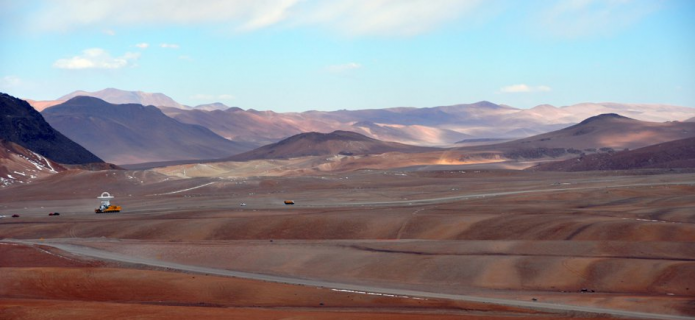ALMA telescope reaches new heights
The ALMA (Atacama Large Millimeter/submillimeter Array) astronomical observatory has taken another step forward and upwards. One of its state-of-the-art antennas was carried for the first time to the 5000m plateau of Chajnantor, in the Chilean Andes, on the back of a custom-built giant transporter. The antenna, which weighs about 100 tons and has a diameter of 12 meters, was lifted to the high-altitude Array Operations Site, where the extremely dry and rarefied air is ideal for ALMA’s observations of the universe.
The conditions at the Array Operations Site on Chajnantor, while excellent for astronomy, are also very harsh. Only half as much oxygen is available as at sea level, making it very difficult to work there. This is why ALMA’s antennas are assembled and tested at the lower 2900 m altitude of the ALMA Operations Support Facility (OSF). It was from this relatively hospitable base camp that the ALMA antenna began its journey to the high Chajnantor site.
“Transporting our first antenna to the Chajnantor plateau is an epic feat which exemplifies the exciting times in which ALMA is living. Day after day, our global collaboration brings us closer to the birth of the most ambitious ground-based astronomical observatory in the world”, says Thijs de Graauw, ALMA Director.
The trip began when one of the two ALMA transporters lifted the antenna onto its back, carrying its heavy load along the 28 km road from the Operations Support Facility up to the Array Operations Site. While the transporter is capable of speeds of up to 12 km/hour when carrying an antenna, this first journey was made more slowly to ensure that everything worked as expected. This took about seven hours.
The ALMA antennas use advanced technology which has only been available for a few years, and are the most sophisticated submillimeter wavelength antennas ever made. These are designed to operate fully exposed in the harsh conditions of the Array Operations Site. This means surviving strong winds and temperatures between -20 and +20 Celsius whilst being able to point precisely enough that they could pick out a golf ball at a distance of 15 km, and to keep their smooth reflecting surfaces accurate to better than 25 micrometers (less than the typical thickness of a human hair).
“This milestone is the culmination of 8 months of effort by ALMA engineers and scientists in assembling and verifying the performance of the antenna over the range of operations needed to confirm its readiness for scientific commissioning”, says Joseph McMullin, ALMA Assembly, Integration and Verification (AIV) System Integration Lead.
Once the transporter reached the high plateau it carried the antenna to a concrete pad — a docking station with connections for power cables and fiber optics — and positioned it with an accuracy of a few millimeters. The transporter is guided by a laser steering system and, just like some cars today, also has ultrasonic collision detectors. These sensors ensure the safety of the state-of-the-art antennas as the transporter drives them across what will soon be a rather crowded plateau. Ultimately, ALMA will have at least 66 antennas which can be placed on any of about 200 pads, spread over distances of up to 18.5km and operating as a single, giant telescope. Even when ALMA is fully operational, the transporters will be used to move the antennas between pads to reconfigure the telescope for different kinds of observations.
This first ALMA antenna at the high site will soon be joined by others, and the ALMA team look forward to making their first observations from the Chajnantor plateau. They plan to link three antennas by early 2010, and to make the first scientific observations in the second half of 2011.
ALMA will help astronomers answer important questions about our cosmic origins. The telescope will observe the Universe using light with millimeter and submillimeter wavelengths, between infrared light and radio waves in the electromagnetic spectrum. Light at these wavelengths comes from some of the coldest, but also from some of the most distant objects in the cosmos. These include cold clouds of gas and dust where new stars are being born and remote galaxies towards the edge of the observable universe. The Universe is relatively unexplored at submillimeter wavelengths, as the telescopes need extremely dry atmospheric conditions, such as those at Chajnantor, and advanced detector technology.
More Information
The Atacama Large Millimeter/submillimeter Array (ALMA), an international astronomy facility, is a partnership of the European Organisation for Astronomical Research in the Southern Hemisphere (ESO), the U.S. National Science Foundation (NSF) and the National Institutes of Natural Sciences (NINS) of Japan in cooperation with the Republic of Chile. ALMA is funded by ESO on behalf of its Member States, by NSF in cooperation with the National Research Council of Canada (NRC) and the Ministry of Science and Technology (MOST) in Taiwan and by NINS in cooperation with the Academia Sinica (AS) in Taiwan and the Korea Astronomy and Space Science Institute (KASI).
ALMA construction and operations are led by ESO on behalf of its Member States; by the National Radio Astronomy Observatory (NRAO), managed by Associated Universities, Inc. (AUI), on behalf of North America; and by the National Astronomical Observatory of Japan (NAOJ) on behalf of East Asia. The Joint ALMA Observatory (JAO) provides the unified leadership and management of the construction, commissioning and operation of ALMA.
Contacts
William Garnier
ALMA Education and Public Outreach Officer
[email protected]
+56 9 77 67 61 99
